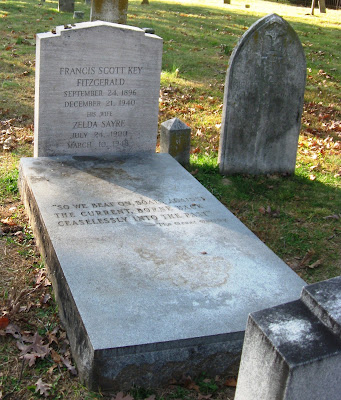St. Mary's Church, Rockville, F. Scott's grave is to the left
F. Scott regularly visited his father's relatives in Montgomery County, and played a small part in (“Ribbon holder”) in his cousin Cecilia wedding at her home at Randolph Station, (A part of Rockville, Maryland) on April 24, 1903. Rockville had a special place in Fitzgerald’s heart and memory. His father was buried at Saint Mary's Church in 1931.
When Scott died at age 44 on December 21, 1940, in Hollywood, California, and his body was shipped to Maryland and on December 27 a small group of family and friends attended the simple service. (As he specified in his will.) at Pumphrey's Funeral Home in Bethesda, in the rain, to Rockville Cemetery. (Not St. Mary’s where he is buried now) He was reinter at St. Mary’s on November 7, 1975.
The Fitzgerald’s daughter, Scottie, is buried there with her parents.
Death Takes Fitzgerald, Noted Author
Heart Attack Fatal to Eloquent Voice of
World War Generation
All the sad young menòthose now grown-up members of the World War generationòhad lost their spokesman yesterday. F. Scott Fitzgerald died of a heart attack in Hollywood at the age of 44. Immediately after word of the death of the author of “This Side of Paradise” was telegraphed to his wife at Montgomery, Ala., arrangements were made through Pierce Bros. mortuary to send his body to Baltimore, Md., his family home, for burial. Readers of the 1930’s did not know Fitzgerald as did those of the postwar era.
For he was the latters’ most articulate voice. His own early life paralleled that of his recurrent protagonist: the young man, caught in a turbulent age, uncertain, seeking.
Zelda, who died in a sanitarium fire on March 11, 1948, is buried with him beneath a common headstone.
Fifteen members of the family-Fitzgeralds, Delihants, Scotts, and Robertsons are buried in the historic Saint Mary's Cemetery.
Composer’s Descendant
Born at St. Paul, Minn., on Sept. 24, 1896, he was christened Francis Scott Key Fitzgerald, after the composer of “The Star Spangled Banner,” an ancestor on his mother’s side. He was first educated at Hackensack, N.J. Then he attended Princeton.There he found much of the atmosphere which fills his first books.
It was wartime. In 1917, deserting the university in his senior year, he entered the Army as a second lieutenant in the 45th Infantry. Two years later he left the service. He was 23.
First Novel Hailed
In 1920 “This Side of Paradise” appeared.Its hero, Amory Blaine, approximated “all the sad young men” of the distracted time. (That phrase was to become the title of a Fitzgerald short-story collection six years later.) Hailed by critics as a great first novel, “This Side of Paradise” was a period piece, a sort of social paper.
At 26, Fitzgerald was in Who’s Who. His clubs were listed as Cottage (Princeton) and Sound View Golf. His politics was Socialist. One critic described his works as documentary “in their vivid presentations of adolescent life, its turbulent spirit, swift tempo, charged atmosphere, excesses and boldness, as well as its uncertain psychology and groping to know itself in new and unadjusted conditions.”
His books also were milestones of this topsy-turvy epoch.
“The Beautiful and Damned” came in 1922, two years after his first novel and “Flappers and Philosophers.” Later he wrote “The Great Gatsby” and “Tender Is the Night.” He saw his generation as truly lost. One of his collected volumes was titled “Taps at Reveille.”
In recent years Fitzgerald wrote no novels. Instead, he came to Hollywood in 1937. He adapted Gatsby to the screen, then did the scenario for Remarque’s “Three Comrades.”
Second Attack Fatal
Three weeks ago he had his first heart attack.Saturday he succumbed to a second.
His life in Hollywood had been quiet. His hobbies were children and water sports. He was a connoisseur of fine wines. Occasionally a Fitzgerald short story would appear in a national magazine. But mostly he worked on his last play for the New York stage. He lived at 1403 N. Laurel Ave.
In 1920 he married Zelda Sayre, daughter of an Alabama Supreme Court justice. They had one daughter, Frances Scott Fitzgerald.
òLos Angeles Times, 23 December, 1940, Part I, pp. 1-2.
F. Scott Fitzgerald Buried
ROCKVILLE, Md., Dec. 27 (AP)òAfter a private service, the body of Francis Scott Fitzgerald, noted novelist, was buried today in the Rockville Union Cemetery. His body was brought to Rockville after a funeral service conducted by the Rev. Raymond P. Black, pastor of the Christ Episcopal Church of Rockville, at a funeral home in Washington. The 44-year-old writer of novels of the Twenties died Sunday in Hollywood, Calif., where he had been a motion picture scenarist.òThe New York Times, 28 December 1940, p. 10.














